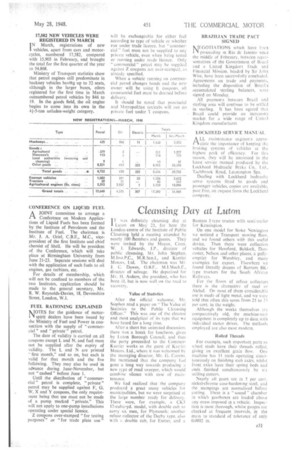Cleansing Day at Luton
Page 33

If you've noticed an error in this article please click here to report it so we can fix it.
IT was definitely cleansing day at
Luton on May 21, for here the London centre of the Institute of Public Cleansing lield a meeting attended by nearly 100 ffiembers and guests. They were invited by the Mayor, Court. W. J. Edwards, J.P.. director of public cleansing, Mr. John Stephen, M.Inst.P.C., M.R.San.I., and Karrier Motors, Ltd. The chairman was Mr. J. C. Dawes, 0.13.E.,,
director of salvage. He deputized for Mr. H. Ardern, the president, who has been ill, but is now well on the road to recovery.
Value of Statistics
After the Official welcome, Mr. Stephen read a paper on " The Value of Statistics to the Public Cleansing Officer." This was one of the clearest and most analytical of its type that we have heard for a long time.
After a short but animated discussion. there was a break for luncheon, given by Luton Borough Council, and then theparty proceeded to the CommerKarrier works as the guest of Karrier Motors, Ltd., where it was welcomed by the managing director. Mr. 0. Crizens. Be mentioned that the company had gone a long Way towards producing a new type of road sweeper, which would combine silence with ease of maintenance.
We had realized that the company produced a great many vehicles for municipalities, but we were surprised at the large number ready for delivery. There were, for example, a CK3 12-cubic-yd. model, with double cab to carry six men, for Plymouth; another refuse collector of the Derby type, also with a double cab, for Exeter, and a Bantam .1-type tractor with semi-Iraiter fir Kensington.
On one model for Stoke Newington we noticed a Transport moving floor, and we found others with this useful device. Then there were collection vehicles for Hereford, Baldoek, Doncaster, Nelson and other places. a gullyemptier for Wembley, and many examples for export. Elsewhere we found literally dozens of Bantam BK type tractors for the South African Railways.
For the floors of refuse collectors there is the alternative of steel or Alelad. On most of them considerable use is made of light metal, and we wete told that often this saves from 25 to 23 per cent, in the weight.
Although the works themselves a re comparatively old, the machine-toot equipment is completely up to date, with individual motor drives. The methods employed are also most modern.
Rolled Threads
For example, such important parts as wheel studs have their threads rolled,
giving an excellent grain flow. One machine has 11 tools operating simultaneously on finishing stub axles, whilst front axles have their spring beds and ends finished simultaneously by six milling cutters.
Nearly all gears are in 5 per cent. nickel-chrome case-hardening steel, and the stampings are normalized before cutting. There is a " sound " chamber in which gearboxes are loaded above ally stress imposed in a vehicle. Inspection is most thorough, whilst gauges are checked at frequent intervals, in the main to standard of tolerance of only 0.0002 in.




















































































